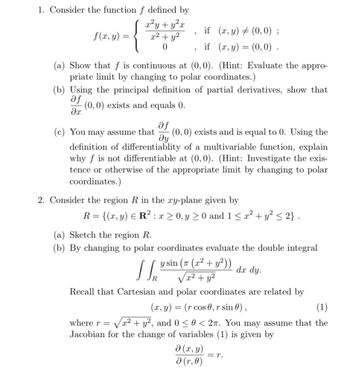
Advanced Engineering Mathematics
10th Edition
ISBN: 9780470458365
Author: Erwin Kreyszig
Publisher: Wiley, John & Sons, Incorporated
expand_more
expand_more
format_list_bulleted
Question

Transcribed Image Text:1. Consider the function f defined by
f(x, y) =
x²y + y²x
x² + y²
0
if (x, y) (0,0);
"
if (x, y)=(0,0).
(a) Show that f is continuous at (0,0). (Hint: Evaluate the appro-
priate limit by changing to polar coordinates.)
(b) Using the principal definition of partial derivatives, show that
(0,0) exists and equals 0.
af
მე
(c) You may assume that
af
მყ
(0, 0) exists and is equal to 0. Using the
definition of differentiablity of a multivariable function, explain
why f is not differentiable at (0,0). (Hint: Investigate the exis-
tence or otherwise of the appropriate limit by changing to polar
coordinates.)
2. Consider the region R in the xy-plane given by
R={(x,y) R² x ≥ 0, y ≥ 0 and 1 ≤ x² + y² ≤ 2}.
(a) Sketch the region R.
(b) By changing to polar coordinates evaluate the double integral
y sin (π (x² + y²))
√x² + y²
dx dy.
Recall that Cartesian and polar coordinates are related by
(x, y) = (r cos 0, r sin 0),
✓
(1)
where r = √√√x² + y², and 0 ≤ 0 < 27. You may assume that the
Jacobian for the change of variables (1) is given by
(x, y)
ǝ (r, 0)
= 1.
Expert Solution
This question has been solved!
Explore an expertly crafted, step-by-step solution for a thorough understanding of key concepts.
Step by stepSolved in 2 steps

Knowledge Booster
Similar questions
- ? Solvearrow_forwardConsider the following. Function: h(x, y) 9у cos (x - у) Point: (0, ) 3. (a) Find the gradient of the function. -9y sin(x - y) i + 9 cos(x - y) + 9y sin(x – y) j (b) Find the maximum value of the directional derivative at the given point. (Give your answer correct to 2 decimal places.)arrow_forwardDay traders typically buy and sell stocks (or other investment instruments) during the trading day and sell all investments by the end of the day. The following table shows the closing prices on September 22, 2015, of 12 stocks selected by your broker, Prudence Swift, as well as the change that day. Tech Stocks Close Change AAPL (Apple) $113.40 -1.81 ADBE (Adobe Systems) $84.66 1.34 EBAY (eBay) $25.61 -0.31 MSFT (Microsoft) $3.90 -0.21 S (Sprint) $4.40 0.02 WIFI (Boingo Wireless) $8.51 0.56 Non-Tech Stocks ANF (Abercrombie & Fitch) $21.81 -0.02 в (Воeing) $133.99 -2.03 F (Ford Motor Co.) $13.91 -0.40 GE (General Electric) $25.10 0.01 GIS (General Mills) $57.12 0.33 JNJ (Johnson & Johnson) $93.26 0.13 On the morning of September 22, 2015, Swift advised you to purchase a collection of three tech stocks and two non-tech stocks, all chosen at random from those listed in the table. You were to sell all the stocks at the end of the trading day. (a) How many possible collections are possible?…arrow_forward
- 2. For the function z = f(x, y) is known f (2, – 1) = -2, f-(2, -1)=-1, f,(2, –1) = 2. Find the following (a) Gradient of f at the point (2, –1) :grad f(2, -1) (b) Directional derivative of f at the point (2, – 1) in the direction of the vector –27+37: fa(2, –1 ). (c) Estimate f(1.99, –1.02) = (d) Differential of f at the point (2, -1)arrow_forward1. (a) Compute the directional derivative of f(x, z) = x²z+xz³ at the point (x, z) = (-2, 4) in the direction û = (3, 1)/√/10. (b) Find the equation of the tangent plane to the surface z = f (x, y) x² - y², at the point (1, 2, -3), in the form ax +by+cz = d. = (c) The function f(x, y, z) = x² + 3xy + 2yz + y² − z² – 11 = 0 defines an implicit function z = z(x, y). Show that the point (x, y, z) = (1, 2, 0) yields f = 0. Find az/ax, dz/dy and evaluate them at the given point (x, y, z) = (1, 2, 0).arrow_forward
arrow_back_ios
arrow_forward_ios
Recommended textbooks for you
 Advanced Engineering MathematicsAdvanced MathISBN:9780470458365Author:Erwin KreyszigPublisher:Wiley, John & Sons, Incorporated
Advanced Engineering MathematicsAdvanced MathISBN:9780470458365Author:Erwin KreyszigPublisher:Wiley, John & Sons, Incorporated Numerical Methods for EngineersAdvanced MathISBN:9780073397924Author:Steven C. Chapra Dr., Raymond P. CanalePublisher:McGraw-Hill Education
Numerical Methods for EngineersAdvanced MathISBN:9780073397924Author:Steven C. Chapra Dr., Raymond P. CanalePublisher:McGraw-Hill Education Introductory Mathematics for Engineering Applicat...Advanced MathISBN:9781118141809Author:Nathan KlingbeilPublisher:WILEY
Introductory Mathematics for Engineering Applicat...Advanced MathISBN:9781118141809Author:Nathan KlingbeilPublisher:WILEY Mathematics For Machine TechnologyAdvanced MathISBN:9781337798310Author:Peterson, John.Publisher:Cengage Learning,
Mathematics For Machine TechnologyAdvanced MathISBN:9781337798310Author:Peterson, John.Publisher:Cengage Learning,


Advanced Engineering Mathematics
Advanced Math
ISBN:9780470458365
Author:Erwin Kreyszig
Publisher:Wiley, John & Sons, Incorporated

Numerical Methods for Engineers
Advanced Math
ISBN:9780073397924
Author:Steven C. Chapra Dr., Raymond P. Canale
Publisher:McGraw-Hill Education

Introductory Mathematics for Engineering Applicat...
Advanced Math
ISBN:9781118141809
Author:Nathan Klingbeil
Publisher:WILEY

Mathematics For Machine Technology
Advanced Math
ISBN:9781337798310
Author:Peterson, John.
Publisher:Cengage Learning,

